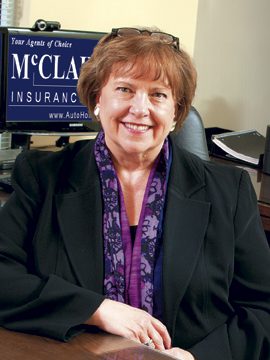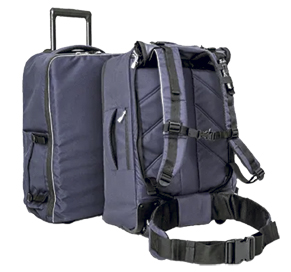Personal Lines Focus
BE PREPARED
Risk management tips, because numerous perils can happen anytime without warning
By Christopher W. Cook
This year, The Walt Disney Company released its “live-action” version of the 1994 animated film The Lion King. While most of us disliked the lion Scar (how many of our childhoods were traumatized by what happened to Mufasa), I came to realize that through his musical number, although delivered in a different context, he provides a valuable lesson: Be prepared.
Everyone should be familiar with the five steps of risk management: Identify, Analyze, Control, Finance, and Monitor. Products like wearable technology can help manage risk for factory workers, and “wet floor” caution signs are beneficial for restaurants and bars. But those are your commercial lines customers. What can be done regarding risk management for your personal lines clients? How can they be prepared for the numerous perils that can happen anytime without warning?
McClain Insurance Services, an agency that’s 100% personal lines, located in Everett, Washington, offers its new clients a welcome gift to help manage their risks.
“In the past, our welcome gifts have been water leak detectors, child ID booklets, etc.,” says Claudia McClain, founder of the agency. “Currently we offer an agency-branded three-in-one emergency escape tool.”

-Claudia McClain
Founder
McClain Insurance Services
The escape tool, which is part of the agency’s new client onboarding process—a detailed two-month communications planner featuring handwritten cards, an introduction to the team and description of the agency’s referral program—includes an emergency flashlight, a vehicle window breaker and a seatbelt cutter. The welcome gift is mailed one week after the client comes onboard.
Another “gift” offered by the agency is a free defensive driving course for its clients who are 55 and older. The course is offered in a classroom or online setting and “qualifies attendees for a 5% to 10% discount on their auto policies,” says McClain.
The agency has also “partnered with VLES designs (see sidebar) to offer a 10% discount to our clients who would like to purchase preparedness equipment, including GO-bags, for future catastrophes,” she adds. The company’s downloadable Readiness Playbook will also be made available to all clients and prospects.
BKS Partners, headquartered in Tampa, Florida, also educates its personal lines clients on risk management strategies.
“Risk management advice is available on our website and client portal, as well as shared through our ‘News You Can Use’ newsletter and webinars,” says founding partner Laura Sherman, CAPI, CPRM. “We create educational webinars on risk management topics that are important to our clients regarding water damage prevention, cyber security, domestic staff best practices, protecting valuables, what to do in the event of an accident, life insurance 101, etc.”
Regarding their clients’ homes, “we provide tips on the most overlooked components of home maintenance and a sample annual maintenance calendar,” Sherman says.
This includes scheduling routine roof inspections by a qualified roofer to ensure that shingles and tiles are in good shape, as well as recaulking windows, doors and skylights to prevent water intrusion.
“Water is the number one cause of loss for all home owners, and 93% of it is preventable with proper maintenance,” says Sherman. “Sand, grit, and other minerals that haven’t dissolved into your water can collect at the bottom of your water heater and flushing it once a year boosts performance and lengthens lifespan. Replace hoses with stainless steel braided hoses or flood-smart hoses on all appliances and plumbing fixtures. And consider a water security system—whole house systems are available that can shut off the water supply, are incredibly affordable and will alert you on usage, possible leaks, etc.”
Emergency preparedness
How prepared are you—and your clients—if a disaster suddenly strikes? What if a clan of hyenas led by a mistrustful lion invades your town, or a more realistic fiasco occurs?
“We have a step-by-step guide on how to create a customized family catastrophe guide, everything from preparing an emergency supply kit, to custom art crates, gauging time to prepare your home and yard for a hurricane to communication protocols,” says Sherman. “We host a hurricane preparedness webinar annually with a microsite of resource materials to help our clients and colleagues prepare. We also work with our insurers, many of which have catastrophe response teams for wildfire and hurricane planning.”
September was Emergency Preparedness Month, and to prepare their clients “we communicated daily on our social media and focused on the topic,” McClain says.
Last year’s 30-day National Preparedness Month Challenge provided clients information to assist with being ready throughout the year. Each week addressed a different topic:
Week one: Make and practice your plan. The first week focused on setting emergency goals and plans—like a fire escape route—and having them practiced by all members of the household. It also shared valuable technological information like apps where one could sign up to receive emergency alerts or group texting options for when Wi-Fi is not available. The first week also stresses researching which disasters are most likely to occur in your area—floods, earthquakes, severe storms or wildfires. Develop a family plan for these scenarios and practice, practice, practice.
Week two: Learn life saving skills. The second week covered making sure the safety equipment in your house is up to date and functioning properly. Test your smoke detectors and carbon monoxide monitors and make sure that everyone who is able to use one knows how to operate a fire extinguisher. Does your home have fire extinguishers? Check the household for fire hazards like faulty wiring, dirty chimneys or an overflowing lint filter in the clothes dryer. Also, make sure everyone is aware of how to shut off the water and gas lines. The week ends with learning basic life-saving skills and building a basic emergency kit.
Week three: Check your coverage. The third week focused on reviewing your current insurance policies and the consideration of updating coverage. Think about investing in earthquake or flood policies. Create a home inventory—whether through photographs or video—of all your possessions in case a claim needs to be filed, and even though agencies are leaning toward being 100% paperless, have a hard copy of your insurance information handy in your emergency kit.
Week four: Save for an emergency. The final week helped home owners prepare financially for after a disaster and included tips like keeping cash in your emergency kit, signing up for direct deposit with your financial institution, and completing a financial first aid kit, which would include a record of your monthly financial obligations in case you were forced out of your home or didn’t have the information available. It also provided tips like safeguarding critical documents and connecting with your community to see what kind of assistance programs may be available during emergency situations.
Daily and weekly themes may change from year to year, but emergency preparedness is focused on each September, since the inception of National Preparedness Month in 2004.
Annual review
Another aspect of managing your clients’ personal risks is holding an annual review.
“The most important part of personal lines risk management is committing to annual reviews with each client,” says McClain. “I know that this can be a daunting—and expensive—task.
“Our goal is to reach every client, every year, with a phone call to update current contact information, review all available discounts and opportunities—like telematics—that can help reduce rates, and make recommendations for enhanced coverage or additional lines of business, while thanking our clients for their years with the agency.
“We operate with a hybrid approach where our team members both sell and service,” she continues. “Each team member receives a list from that morning’s download of all clients needing a renewal review call that day. We call every auto renewal and all other clients with a monoline policy that is renewing.
And of course, what gets measured gets done, so McClain provides team members a report each month of the following metrics:
- Account review attempts
- Account review successes (they actually made contact and had an in-depth conversation)
- Cross-sell attempt
- Cross-sell success
- Remarketing attempt (Our focus is not to suggest remarketing, but we track the metric)
- Remarketing success
- Upgrade (which includes increased liability, UIM and PIP limits, updated replacement cost valuators, additions of HO endorsements like water backup, enrolling in telematics programs, etc.)
But the agency didn’t always conduct this thorough procedure.
“When our bandwidth was limited, these calls were often limited to saying, ‘thank you for your business’ instead of actually having specific topics outlined that would bring value to the client—and ultimately to the agency,” McClain recalls. “Since last year, we’ve been working with Kelly Donahue-Piro of Agency Performance Partners. She has coached our team through a rigorous, yet achievable, action plan that involves identifying in advance the primary topics that would be relevant to each specific client, and using our HawkSoft agency management system to document that pre-work in the event that a client can’t be reached on the first call. In this way, any agency team member can step in and work the review when the client responds.

-Laura Sherman, CAPI, CPRM
Founding Partner
BKS Partners
“Kelly’s training was a terrific help to get everyone on the same page, and she met with the team via video conference call every two weeks for five months to work through the inevitable questions and objections. It’s been a great way for us to systematize the process of recommending upgrades to existing policies and cross-sells of additional lines of business.”
The annual review provides a good opportunity for educating clients and recommending beneficial products to them. BKS Partners suggests “prevent text” apps like Life360, SafeDrive or Hawkeye—which can also monitor location and speed—during renewal meetings or when clients add a teenager to their policy.
“We also counsel clients on fire safety during our annual renewal meetings,” says Sherman. “Topics include life-saving devices that may also provide a premium credit, such as cellular backup, carbon monoxide detectors, gas leak detectors, Plumis (an alternative domestic fire sprinkler), and temperature versus smoke detectors. We mention checking fire extinguisher expiration dates and creating a fire safety plan.
“Everyone should have a fire safety plan for the family to exit the home, including multiple exits, such as a ladder in an upstairs bedroom, or work with the fire department to know where the bedrooms are located on a larger property. For homes that are gated, we recommend installing a Knox Box so the fire department can gain access if clients are away.”
Offering your personal lines clients risk management tips, products and strategies can help them be better prepared for perils in the future. And even though those perils can occur without notice—in the meantime, Hakuna Matata.
For more information:
BKS Partners
www.bks-partners.com
McClain Insurance Services
www.autohomeboat.com
The VLES GO-Bag
An expectant mother can prepare for the birth of her child by packing a bag of supplies to take to the hospital. However, unlike a pregnancy’s “due date,” natural disasters can happen at any time without any warning. Stuart Warshaw, co-founder of VLES designs, had commuted to and was working in New York City, approximately two miles from the World Trade Center, at the time of the 9/11 terrorist attacks. Ten years later—after becoming a resident of the city—he called Hurricane Sandy another eye opener.
“We were shocked by how unprepared people really were,” Warshaw notes. “During 9/11, we weren’t prepared. We didn’t have food. We couldn’t shelter in place at our company.
“Everybody needs to be prepared because things are going to happen and professional response is spread too thin,” he adds. “The idea is to be able to take care of yourself for 72 hours (or three days).”
Warshaw and his wife, Karina, both have backgrounds as volunteer responders and spent years with their colleagues discussing the design and development of their product, the VLES GO-bag.
“It was built with an enormous amount of input from professional responders we had worked with, and we spent lots of time getting it right,” he notes.
The bag can be rolled, worn as a backpack or carried by one of its strategically placed handles. It is made of waterproof fabric and has a a built-in tether for guiding children, a water bottle pocket, and hands-free flashlight straps. Other items included in the bag are a first aid kit, emergency radio, heavy-duty rope, safety glasses, and duct tape.
 “The bag has 25 specific design features, some not visible to the eye,” says Warshaw. “We manufactured it and stocked it with items that are well known and defined on websites like FEMA or the Red Cross.”
“The bag has 25 specific design features, some not visible to the eye,” says Warshaw. “We manufactured it and stocked it with items that are well known and defined on websites like FEMA or the Red Cross.”
The bag and supplies can be purchased individually or together, but even a bag containing all the available supplies has “nearly 50% capacity free to put your own stuff in,” says Warshaw.
The fully stocked VLES GO-bag is designed to hold supplies for two people, and a Friend’s Pack that contains additional supplies for a third person is also available. The company also sells a Car Kit, which contains items like gloves, emergency blankets and a flashlight with batteries.
“When it comes to a crisis,” says Warshaw, “why do people wait for one to occur? That’s not being prepared; it’s being reactive.”
A key item available on the website is a free downloadable Readiness Playbook.
“We make it easy for someone to create a plan,” says Warshaw. “It starts with a quick quiz to show people that they aren’t ready for a crisis, and then it explains how to get prepared. It walks you through the process of what personal items to put in your bag. It includes forms for prescriptions and medical notes, so someone can create a family plan and know what to do during a crisis.
“When you look at emergencies, communication is important, but number one is having a plan,” he concludes.
For more information:
VLES designs
www.vlesdesigns.com






